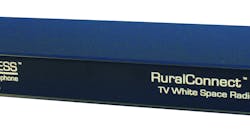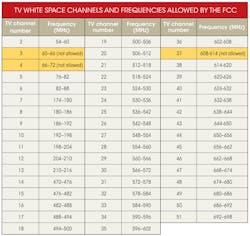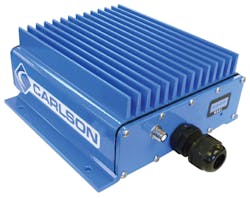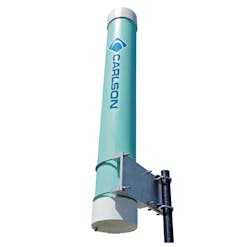White space is the name given to unused TV channels in various locations around the U.S. and in some other countries. The Federal Communications Commission (FCC) usually spaces the TV channels apart to prevent one from interfering with another, leaving blank unused channels in between.
These unused channels can be deployed for other communications purposes, making free spectrum useful. Sometimes called TV white spaces (TVWS), these channels can be repurposed as needed if the requirements of the FCC are met. TVWS is called Super Wi-Fi and White-Fi as well, although it does not have anything to do with the real Wi-Fi.
This file type includes high resolution graphics and schematics when applicable.
The White Space Spectrum
In the U.S., the TV spectrum lies between 54 MHz and 698 MHz divided into 6-MHz wide channels (see the table). Any of these channels can potentially be used license-free. The availability of a particular channel depends on its location and the TV station assignments that vary widely across the country.
The exceptions are channels 3, 4, and 37, which cannot be used. Channels 3 and 4 are still reserved for connecting RF modulators to TV set antenna terminals. Channel 37 is assigned to radio astronomy for use in monitoring various RF conditions in the universe.
The most useful spectrum is from channel 14 (470 MHz) through channel 51 (698 MHz). At these higher UHF frequencies, the antennas are shorter and more manageable than antennas for VHF channels 2 (54 MHz) through channel 13 (216 MHz).
The great value of this spectrum is its potential for longer-range communications than are possible with other wireless services above 2 GHz. According to Friis’s law, the range of a radio depends on the wavelength where shorter wavelengths (higher frequencies) travel shorter distances for a given power level, receiver sensitivity, and antenna gains. Whereas a 2.4-GHz signal may travel up to several kilometers under the right conditions, a signal in the UHF range from 470 MHz to 698 MHz can travel many miles, up to 100 miles in some cases.
While all UHF and microwave signals basically travel line of sight (LOS) from transmitting antenna to receiving antenna, the lower frequencies are better at penetrating trees, buildings, and other structures than the higher frequencies, which are more easily absorbed and reflected. As a result, TVWS frequencies are often referred as non-line of sight (NLOS) spectrum. Where long range is needed and obstacles are a problem, the white spaces are an excellent option.
Besides the standard over-the-air (OTA) TV stations, this spectrum is used for other purposes, making the identification of free channels tricky. Typical of other applications are low-power local TV, TV repeaters/translators, wireless microphones, and auxiliary equipment. Some areas even use these channels for land mobile service, and some Gulf of Mexico regions use it for offshore telephone service.
One approach to finding the right channel is spectrum sensing, where the basestation receiver listens on the various channels to see what is taking place. If a signal within specific parameters is sensed, no transmission takes place and other channels are tested for activity.
The real key to finding an open channel is to know what services are nearby. An FCC-mandated master database records all devices and stations using the TV channels. Before a white space basestation can transmit, it must reference the database.
How It Works
A white space system usually consists of a master fixed basestation and one or more remote portable, mobile, or fixed terminals. All of the radios involved are frequency-agile, so they can switch quickly and automatically to a wide range of channels. Fixed basestations can operate on any channel from 2 to 51, but mobile devices are restricted to channels 21 to 51.
All fixed station units must have a geolocation capability that generally translates to an internal GPS receiver. Portable and mobile devices may have their own geolocation capability or may get their location by way of the fixed station to which they communicate.
In addition, all fixed stations must have access to the master database of stations and equipment. They also must supply their location to the database. Before a station can transmit, it must access the database to get a list of channels available for use and sense activity for possible interference. All devices must check the database periodically to see if conditions have changed.
A portable device can obtain its location information and list of available channels from the fixed station. Otherwise, it may have its own geolocation capability and database access capability. Furthermore, all devices must have an adaptable power output control so minimum power is used at all times to ensure minimum interference. In all cases, operation of a fixed station may not occur in a channel directly adjacent to an active TV channel.
The FCC restricts power levels to 1 W for basestations or 4 W effective isotropic radiated power (EIRP) with a gain antenna. Antenna height is restricted to 30 meters above ground. For mobile units, the maximum power is 40 mW or 100 mW EIRP.
A third party selected and approved by the FCC develops, maintains, and administers the database. There are 10 authorized database administrators including Google, iconectiv (formerly Telecordia), Key Bridge Global, Microsoft, and Spectrum Bridge. White space equipment and systems vendors select the database to use. Access to the database is usually via an Internet connection that operates in real time with the operation of the system.
The ability of a station or device to automatically check the database, provide location information, and select an appropriate channel means that the radios are intelligent. This is one form of what is called cognitive radio.
The Code of Federal Regulations (CFR) Title 47, Part 15, Subpart H spells out the details of operation and specifications. Another good reference is the FCC’s Third Memorandum Opinion and Order (FCC 12-36) related to Dockets 04-186 and 02-380 (http://hraunfoss.fcc.gov/edocs_public/attachmatch/FFCC-12-36A1.pdf).
White Space Standards
Current white space radios use proprietary designs, either single carrier with quadrature phase-shift keying/quadrature amplitude modulation (QPSK/QAM) or orthogonal frequency-division multiplexing (OFDM). However, some standards for white space have been developed, including IEEE 802.11af, 802.22, and Weightless.
The 802.11af standard is based on the existing Wi-Fi standards but modified for the white space bands and the unique needs of the media access control (MAC) layer. It uses OFDM with binary phase-shift keying (BPSK), QPSK, 16-phase QAM (16QAM), or 64-state QAM (64QAM) using fast Fourier transform (FFT) sizes of 64, 128, 256, and possibly 512 or 1024.
The radios may operate in a 5-MHz bandwidth, although bandwidths of 10, 20, and 40 can be used if multiple TVWS channels can be bonded or combined, contiguous or non-contiguous. The data rate is 12 Mbits/s. The access method is carrier-sense multiple access with carrier sense (CSMA/CS) and time-division multiple access (TDMA). Duplexing is time division duplex (TDD).
The standard also uses a convolutional code for forward error correction (FEC). It is designed to interface with a geolocation device and the external database as well as deploy spectrum sensing. Maximum range is expected to be <100 meters indoors, as with standard Wi-Fi, or up to about 5 km outdoors under the right conditions. The standard is still under development, but final ratification is expected in 2014.
The 802.22 standard was developed to create a wireless regional area network (WRAN) or metro network standard similar to WiMAX (802.16). Ratified in 2011, it is readily available for TVWS development. As a more complex and robust standard than 802.11af, it offers speed and range advantages with some cost tradeoffs.
The modulation method again is OFDM using QPSK, 16QAM, and 64QAM with an FFT size of 2048. It can operate in channel widths of 6, 7, and 8 MHz. The data rate is 22.69 Mbits/s. The access method is orthogonal frequency-division multiple access (OFDMA). Like 802.11af, duplexing is TDD.
The standard also can use a convolutional code for FEC, but optionally other FEC can be used like convolutional turbo codes (CTC), low-density parity check (LDPC), or stream-based trace compression (SBTC) that further improve reliability, speed, and range because of coding gain. The typical range is 17 to 33 km with a maximum of up to 100 km under good conditions.
Until the standards are finalized, most commercial TVWS equipment will continue to use proprietary standards. This is not a disadvantage for specific applications or systems, but widespread roaming and portability will be restricted to a defined geographical area.
Carlson Wireless Technologies designed its RuralConnect software-defined radio (SDR) specifically for TVWS. Used in multiple test sites and in several rural broadband wireless Internet services, it can be used to form both point-to-point and point-to-multipoint networks. The equipment is designed to operate from 470 to 698 MHz with 6-MHz channels or 470 to 786 MHz in 8-MHz channels for Europe (Fig. 1).
The basestation has an output power of 200 mW and feeds the antenna through a 75-Ω F connector. Receiver sensitivity for a 10–6 bit error rate (BER) is –93 dBm using QPSK. 16QAM is also available. Data rates of 4, 6, 8, 12, and 16 Mbits/s are possible either fixed or adaptive. The duplexing is TDD. The data interface is 10/100 Ethernet. The unit uses a standard rack mount.
A typical situation is 10 clients with an downlink/uplink capability of 3.2/1.6 Mbits/s. The customer premise equipment (CPE) units have similar specs but with different packaging (Fig. 2). The range will vary with local conditions and the coding rate. Ranges of 2 to 12 miles are possible. The Carlson system is fully FCC certified, so it is ready for immediate deployment.
Carlson also has a good matching antenna (Fig. 3). It is a vertically polarized omnidirectional array that can operate over the 470- to 786-MHz range. The gain is 5.2 dBi. The voltage standing wave ratio (VSWR) is 1:1.8 using either 50- or 75-Ω cables with N or F connectors, respectively.
While the number of TVWS equipment makers is small right now, more are expected as this wireless method is adopted. Other equipment manufacturers include Adaptrum, KTS Wireless, Neul Ltd., Redline Communications, and Ruckus. MediaTek, Neul, and RealTek have TVWS-related chips.
With hardware standards still in flux, there is need for a common standard and protocol for white space applications. One growing standard effort for machine-to-machine (M2M) applications is Weightless. The Weightless SIG strives to coordinate members to foster the development of a new and more relevant standard to enable M2M applications in white space.
With M2M and its cousin the Internet of Things (IoT) predicted to enable up to 50 billion new devices by 2020, a common efficient specification is important. (For details on the M2M and IoT movements, see “The Connected World Awaits.")
The Weightless specification meets the needs of M2M and IoT. These basic requirements mean very low cost (e.g., $2 modules), low power and long battery life (years), small data packets (<50 bytes), low speed to high speed, TDD to fit white space spectrum limits, ability to handle many subscribers, and tolerance for long latency.
The physical layer (PHY) uses single-carrier modulation schemes of BPSK, QPSK, and 16QAM. It also supports direct-sequence spread spectrum (DSSS) with variable spreading factors. Spreading also implies long headers up to 2 seconds. Frequency hopping is supported to minimize potential interference. Speeds can range from 2.5 kbits/s up to 16 Mbits/s depending upon the need. A typical TDMA format is 24 user uplink time slots. Authentication and encryption features are said to be “cellular grade.”
Neul already has a chip designed to meet the specifications. This CMOS chip, called the ICENI, operates from 169 to 960 MHz and comes in a 6- by 6-mm ball-grid array (BGA) package. Complete modules are expected in the near future.
The standard details are closely held. You must be a member of the SIG to get all the facts and features. See the Weightless website at www.weightless.org for more information. Nevertheless, Weightless seems promising as it is a standard specifically not only for white space but also M2M and IoT.
White Space Applications
There are many potential applications for the white space channels where other wireless technologies come up short. Those with the greatest potential include wireless Internet service, backhaul for other wireless services, telemetry, and M2M.
White space is ideal for providing Internet connectivity in rural areas where long distances and challenging physical environments are involved. Even in mountainous and forested areas, ranges of several miles can be achieved based on actual tests. Users with no cable TV or DSL service can get fast interconnections even in the most remote locations. White space is also a good fit for municipal broadband applications.
Telemetry and M2M applications are already deployed. These applications require the remote monitoring and/or control of distant facilities or infrastructure components, including pipelines, oil rigs, tank farms, electric substations and the Smart Grid, smart metering, vehicle and other asset tracking, traffic monitoring, and dozens of other industrial uses. TVWS systems are also adaptable to marine applications or used for video surveillance. Systems using supervisory control and data acquisition (SCADA) are a prime target for white space wireless.
Critical Issues
While TVWS has potential, several issues need to be monitored and considered. First, radio equipment will continue to be expensive due to the lack of specific chips designed for this technology. Now that radio standards are being finalized, someone needs to make a cheap baseband IC for 802.11af and 802.22. This will speed development considerably and make equipment more affordable.
Second, the FCC is planning an incentive spectrum auction in the near future that will involve selling off parts of the 600- to 700-MHz spectrum for cellular usage. The FCC is asking broadcasters to give up existing channels and/or relocating channels for payment.
The existing cellular carriers will happily buy this spectrum for billions so they can expand their networks and keep up with the constant demand for faster services. Some or all of the channels from 36 (602 MHz) to 51 (698 MHz), then, would not be available. TVWS will keep moving forward, but its operational range will be restricted.






